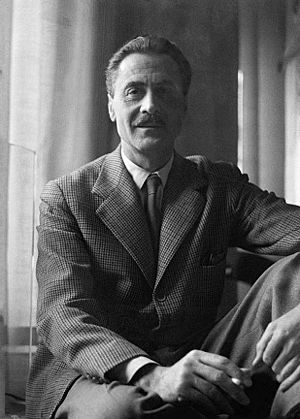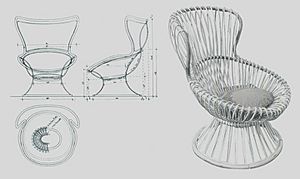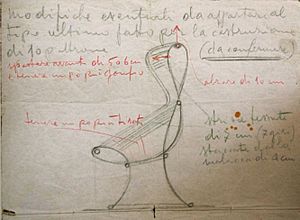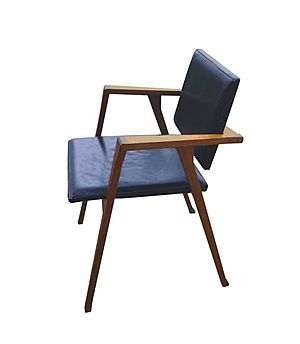Franco Albini facts for kids
Franco Albini (born October 17, 1905 – died November 1, 1977) was a famous Italian architect and designer. He was also a university teacher. Albini is known for mixing old Italian craftsmanship with new, modern design ideas.
Contents
Early Life and Career Beginnings
Franco Albini was born in Robbiate, a town near Milan, Italy. He studied architecture at Politecnico di Milano University and graduated in 1929. After finishing his studies, he started working for another well-known architect, Gio Ponti. In 1930, Albini opened his own design studio. He began showing his work at the Milan Triennale, a big exhibition for art and design.
Albini's Unique Design Style
Albini's designs were special because they brought together traditional Italian skills with modern styles. He often used simple, affordable materials. He was very good at using the talents of Italian craftspeople. This led to elegant designs that looked very clean and simple, a style called minimalism.
One of his early successful designs was a radio from 1939. It was made with a glass case so you could see all the parts inside!
Famous Furniture Designs
Albini created many iconic furniture pieces that are still loved today.
- In 1928, he designed the "Albini Desk." It combined steel, glass, and wood in a balanced, minimalist way. The company Knoll started selling it in 1949.
- In 1950, he designed the popular "Margherita" and "Gala" chairs. These chairs were made from woven cane.
- He created the "Fiorenza" armchair for Arflex in 1952.
- In 1955, his "Luisa" chair won the Compasso d'Oro, a very important Italian design award.
- The "Rocking chaise" for Poggi was designed in 1956.
Big Architectural Projects
In the 1960s, Albini worked on large architectural projects in addition to his industrial designs.
- In 1961, he designed the Rinascente building in Rome, a famous department store.
- Three years later, he worked with Franca Helg and Bob Noorda to design the subway stations for Milan Metro Line 1. He also designed stations for Milan Metro Line 2 starting in 1969.
- In 1964, a television set he designed for Brionvega was shown at a big exhibition in Milan. In the same year, he created various lamps for Arteluce.
Albini designed products for many well-known companies, including Brionvega, Cassina, Arflex, Arteluce, and Poggi.
Other Contributions and Teaching
Franco Albini was also an interior designer. For example, in 1945, he designed the inside of the Zanini Fur Shop in Milan.
He also worked as a writer and editor for the Italian magazine Casabella from 1945 to 1946. Albini loved to teach. In the 1950s and 1960s, he taught interior design at the Venice School of Architecture. From 1963 until his death in 1977, he taught design at Milan Polytechnic.
Awards and Recognition
Albini received many important awards for his work.
- In 1971, he was named an Honorary Royal Designer for Industry (RDI) by the Royal Society of Arts in London. This is a very high honor for designers.
- He won the Compasso d'Oro award three times. This is the most respected design prize in Italy.
See also
 In Spanish: Franco Albini para niños
In Spanish: Franco Albini para niños






